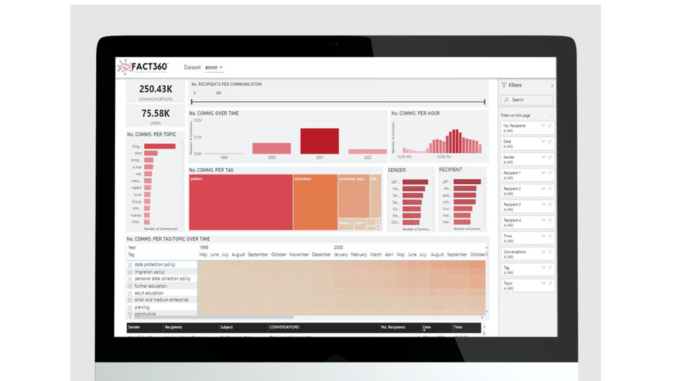
Fact360 is a machine learning startup that first grew out of work conducted at Goldsmiths University, then in 2020 went its own way. Its claimed unique capability is the way it can provide a highly detailed, real-time picture of communication networks inside organisations – a kind of living temporal map – that greatly boosts the analytical powers of those conducting legal investigations.
Andy Slater, Commercial Director at the UK-based company, said that unlike other products that cover eDiscovery and investigations, Fact360 can ‘create a temporal network’ that shows how people’s relationships in an organisation change over time and where sudden shifts in the intensity of relationships can be detected. These ‘anomalies’ can help investigators to spot conspiracies taking shape.
For example, the relationship between a group of traders can be seen back when things are ‘normal’, then after the fact of an incident coming to light investigators can scroll forwards and backwards through a network’s changes over time to look for clues. This can reveal how perhaps a couple of traders suddenly start messaging each other before transactions with a new intensity not seen before.
The system can also show ‘prestige’, which generally shows a person’s importance in the network. That helps as Slater noted, because the CEO of a company is rarely the one making waves through the internal communications system – as they don’t have much one to one contact with junior staff. However, a junior staff member may turn out to be the lynch pin in a conspiracy to, for example, bilk customers with dodgy interest rates, yet by their job title alone they would perhaps be overlooked.
Slater noted that they have worked with leading law firms such as Quinn Emmanuel on this type of matter, helping the firm to really see what was developing inside a company.
‘We ingest all the data, [e.g. emails and chats] and also voice [transcribed recordings]. We input all of this into the system and we then have a living, breathing picture that can show how the prestige of individuals changes over time and this can reveal subtle changes in behaviour,’ Slater explained.
He added that the tool is self-learning and can handle millions of items as part of a project. It uses natural language understanding – which can focus on what are known as IPCT News Categories. This is the taxonomy that media groups such as the BBC use to build their news archives and categorise stories.
The reason for this is that most people don’t speak in legalese or use the jargon of risk analysts, they use the language of the day, and if you want to break the collected data down into meaningful chunks, then you need a taxonomy that matches standard speech and subject matters.
Without mentioning names, Slater stressed that unlike some products that focus on the clustering of terms – which could have multiple meanings – they instead focus on contextual meaning. And that’s especially important in what could be a conspiracy, as people involved won’t always be using language that obviously refers to what they are doing.
Slater concluded by saying: ‘We are a disruptor and we want to help speed up investigations. This could also be used by HR teams, for example to examine bullying inside an organisation [as it would show behaviour changes among a group of staff].’
Overall, this looks to be a useful expansion of the investigator’s toolkit, which focuses on real world relationships rather that just looking at the surface of an organisation.